Finding People and Places: Using directories and almanacs for house and local history
By Christina Ealing-Goldbold, Research Librarian, Library and Client Services | 27 July 2024

Neighbours, businesses, storekeepers – who lived in that neighbourhood in 1895, and who was still there in 1923? Exactly where was the house on Petrie Terrace where your great grandfather lived? Was there always a house on that block of land or was it built later on? Can I find a list of printing firms in Brisbane in 1911? What about carriage builders? All these questions and more can be answered by searching postal and commercial directories and almanacs.
Directories of all kinds have been published for many hundreds of years. Among these are street directories, business directories, farmers directories (or almanacs), travel directories and postal directories.
Almanacs had been published for centuries prior to postal directories. Mini encyclopedias in many ways, almanacs were filled with statistics, calendars, tide and moon information, seasonal agricultural advice and the names of important people and heads of organisations . There were even specialist almanacs such as Wisden’s Cricketers Almanack, Crockford’s Clerical Directory and Bradshaw’s Railway Postal and Road Guide.
Directories and almanacs were also filled with advertisements and were aimed at commercial travelers and companies wishing to be easily located by the business community. This advertisement for the Steam Biscuit Factory is from Slater’s Queensland Almanac of 1876.
Directory publishing was an expanding industry in Victorian Britain and indeed in all major urban areas in the western world – even in Calcutta. The role of postal directories was taken over by the telephone directory after World War Two. The University of Leicester in the UK has a digital collection of almanacs and directories (principally trade and commercial directories) for major British cities in the 19th century.
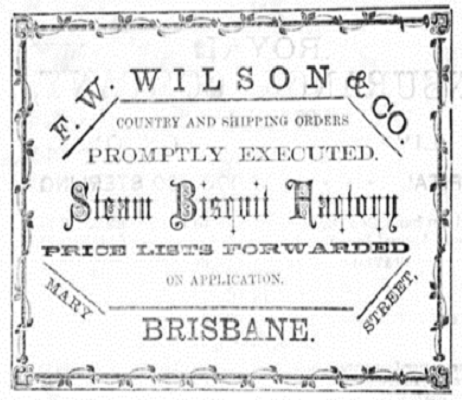
Advertisement for F.W.Wilson & Co biscuit factory. Slater’s Queensland Almanac 1876, p 68. John Oxley Library.
Australian colonies followed the lead of their British sister cities. A town or city had not made the civilised list unless it had a newspaper and a directory. In Queensland, Pugh’s Almanac (named after the editor and publisher, Theophilus Pugh) was the most important 19th century companion for the desk of the businessman, farmer, pastoralist or urban citizen. The almanac included other useful sources such as historical information about Queensland, notable events in chronological order from the previous year (floods, droughts, deaths of well-known persons and sinking of ships among the many topics), expected events in the coming year, as well as notable people in the community. Pughs Almanac was first published from 1859 and is available on microfilm at State Library of Queensland, with annual editions up until 1927. Printed copies are also available in storage.
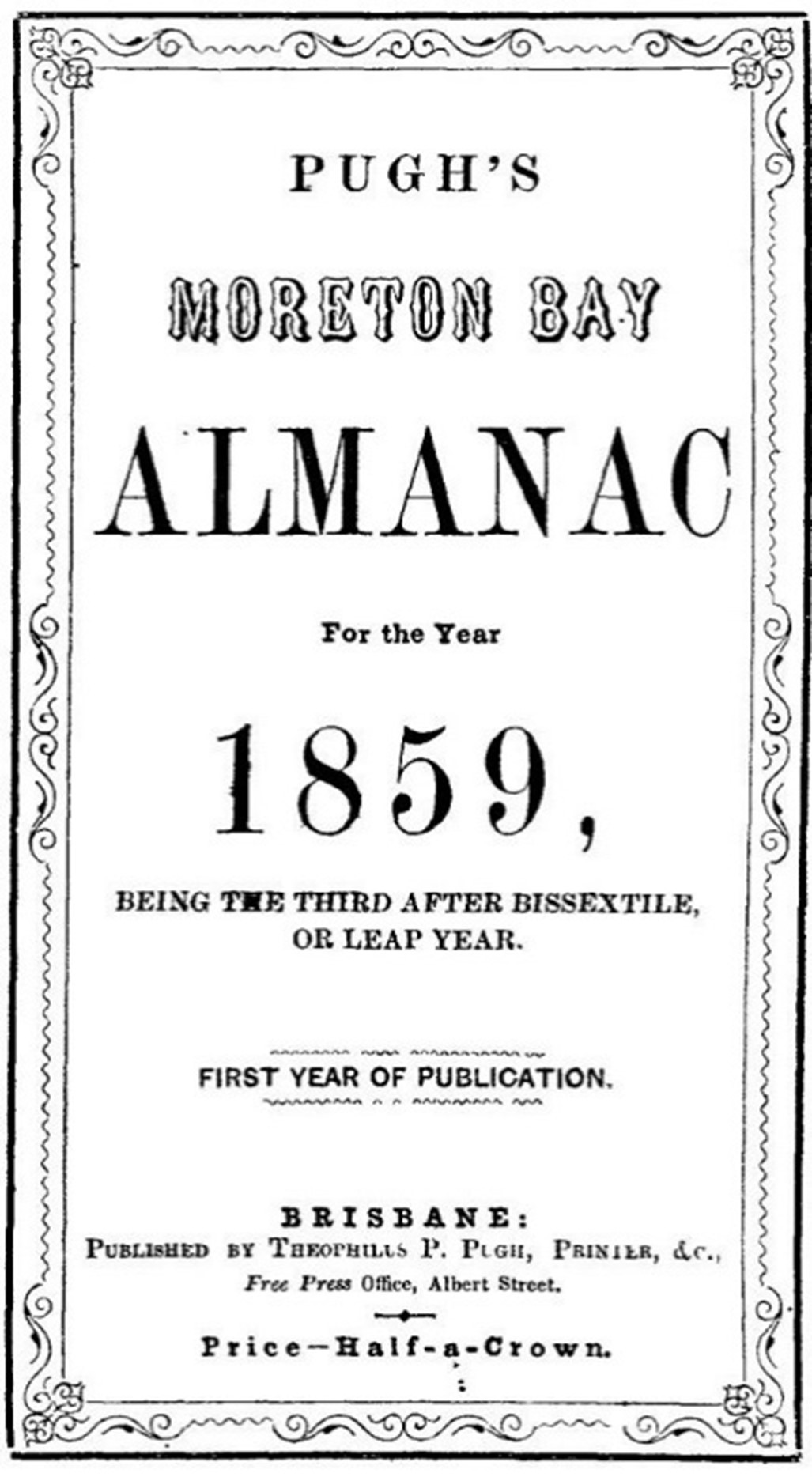
Pugh's Almanac, 1859, John Oxley Library, State Library of Queensland
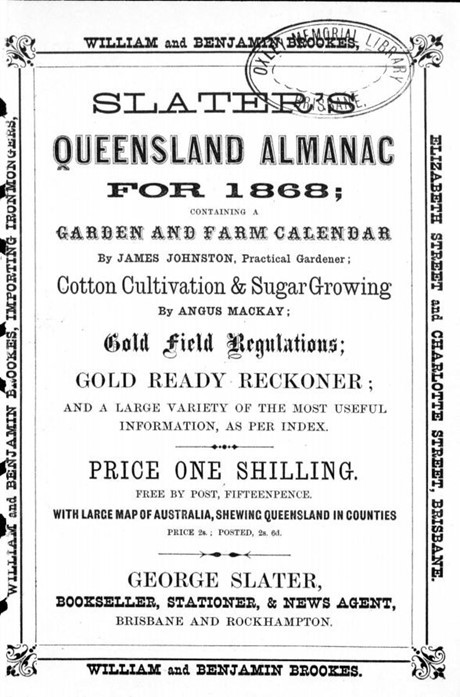
Slater's Almanac, 1868, John Oxley Library, State Library of Queensland
Such was the appetite for directories that most urban centres in the western world had several publications at once, as did Queensland. Other publishers’ names included Slater, Shaw, Holland Meyer, Bailleau and Wise. Slater’s Almanac is available at State Library of Queensland in hard copy in the John Oxley Library, on microfiche on level 3, and has also been digitised and made available online via the State Library catalogue.
At State Library, all Queensland post office directories have now been amalgamated into one chronological resource, regardless of the publisher. Post office directories are available in hard copy, in microfiche and on the Ancestry database under the heading of City Directories. The final years of the publication of postal directories was limited to commercial and occupational listings, as the war years made paper scarce and publishing had to be reduced.
The publishers were:
1868 Meyer
1874 Bailliere
1876 Shaw
1878-1879 McNaught
1883-1899 Watson to Weatherill
1883-1886 Watson
1887 Qld POD Co
1888-1891 Hollander
1892-1899 Weatherill
1889-1899 Wise series 1
1900-1949 Wise series 2
Below is an example of a Wise Directory 1938 listing for Railway Terrace at Milton. Note the house numbers have been added to this inner -city suburb by 1938.
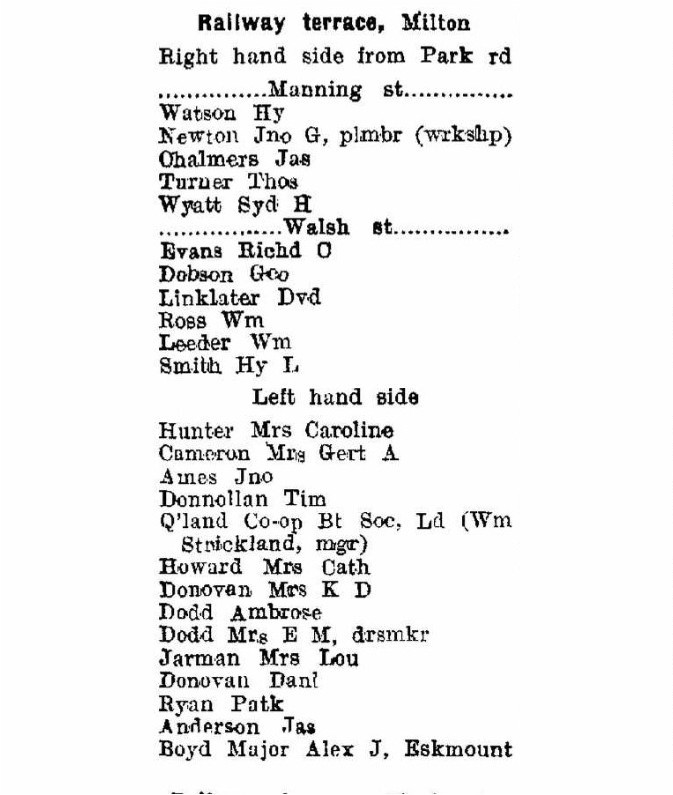
Queensland Post Office and official directory (Wise's), Railway Terrace, Milton, 1913
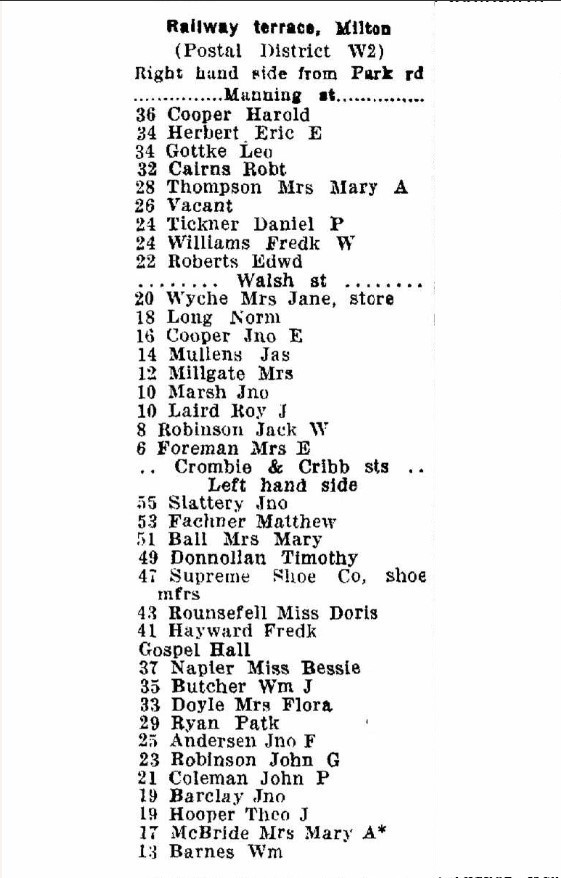
Queensland Post Office and official directory (Wise's), Railway Terrace, Milton, 1938
What to know about Post Office Directories
- Householders and business owners had to pay a yearly subscription to have their name in the directory. If the subscription was not paid the name did not appear in the directory.
- The head of the household was listed. Generally other householders were not listed
- Street numbers were not added until the twentieth century, beginning with the inner suburbs and working outwards.
- House names were sometimes listed in the directories.
How to use a Post Office Directory to find your people
Directories were divided into a number of sections, and knowing the order of the sections will assist you to use the directory most effectively.
The sections are
A: Brisbane directory
• Brisbane
• South Brisbane
• Bayside suburbs- Sandgate, Wynnum, Lota
B: Queensland towns directory
Larger towns such as Ipswich, Toowoomba, Rockhampton and Townsville have street listings in the same way as the Brisbane Directory. Other towns just listed all residents alphabetically.
C: Alphabetical Directory
including all Queenslanders listed, regardless of place or trade.
D: Trade and Occupation Directories
including legal and church listings, and also pastoral and station directories.
Strategies for finding householders and homes
Whether using a directory in hard copy, in fiche, or online, the four sections will be present in post office directories.
- If you need to know where a house was located in a particular street, then Section A is most suitable. Remember that street names may have changed, so check the nearest cross streets on a current map. State Library also has indexes to street name changes.
- If you need to know when a house first appeared in the street, use Section A to compare a number of directories over several years, counting the number of homes from the nearest cross street. It may show a vacant block or an easement or change in street direction, and you may be able to date the house by its appearance in the directories.
- If you have a person’s name but you don’t know where they lived in Queensland, then Section C, the alphabetical directory, is an ideal starting point. From there, you can look at the suburb, town or street and see where the house was located in that street.
- If your ancestor was a carriage builder or plumber, but you are not sure where they lived or worked, Section D, the trades directory, might be your first choice
Searching using online databases (Ancestry or Find my past)
You will need to search city and state directories, choose Australia and then the state. For this search you will need to have a family name to search. Alternatively, you can make your way through the numbered pages (approximately 1,400 pages per issue of the Wise directories) and patiently find the street by checking page numbers. It is useful to know the structure of a post office directory (as outlined above) before attempting this search.
Are you looking for shops and businesses in a suburb?
Find the main street of the town or suburb and follow the shops – the butcher, the fruiterer, the bank, the Post Office and the Cash and Carry store. This listing for Toowong High Street in 1938 provides an excellent example.
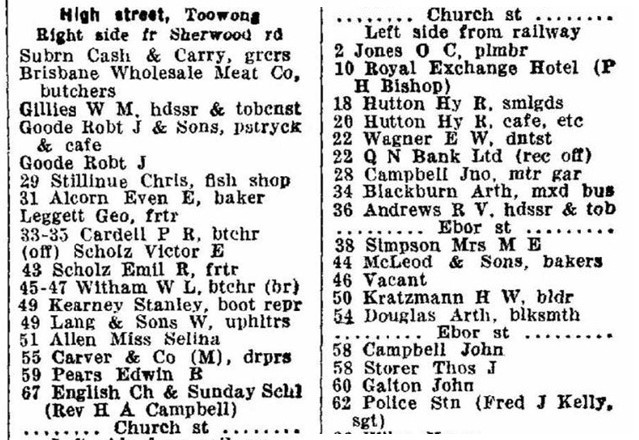
Queensland Post Office and official directory (Wise's), 1938
Selected resources
Almanacs and directories in hardcopy
The official Post Office directory of Queensland (Meyer), holdings: 1868; 1874
Queensland Post Office directory (Weatherill), holdings: 1888-1893; 1895/96-1897/99
Queensland Post Office and official directory (Wise's), Holdings: 1900 - 1908; 1909/1910 - 1931/1932; 1933 - 1938
Slater's Queensland almanac, Holdings: 1868-1869; 1872-1874; 1876-1906; 1908; 1918
Almanacs and directories in microform
The official post office directory of Queensland 1868 (Meyer's)
Pugh's Almanac, 1862-1899
Pugh's Almanac, 1859-1927
Queensland post office directory
Slater's Queensland almanac, Holdings: 1868-1870; 1872-1874; 1876-1892; 1894-1906; 1908; 1918
Almanacs and directories online
Ancestry - available onsite at State Library, for online access to Pugh's Almanac and Wise Directories up until 1938
Slater's Queensland almanac, Holdings: 1868-1869; 1872-1874; 1876-1906; 1908; 1918
Other resources
Fisher, R. (1988). Directories to people, places and patterns in Queensland since 1868. In R. Fisher, & M. Jenner (Eds.), Brisbane: Archives and approaches II (pp. 75-94). Brisbane: Brisbane History Group.
Gorman, M., & Knight, N. (1971). Post Office Filing: the Great Directory Row. Indexer, 7(3), 118
University of Leicester, Historical Directories of England & Wales
More information
One Search catalogue – https://onesearch.slq.qld.gov.au
Library membership – https://www.slq.qld.gov.au/services/membership
Plan your visit – https://www.slq.qld.gov.au/visit
Ask a librarian - https://www.slq.qld.gov.au/services/ask-librarian
Comments
Your email address will not be published.
We welcome relevant, respectful comments.